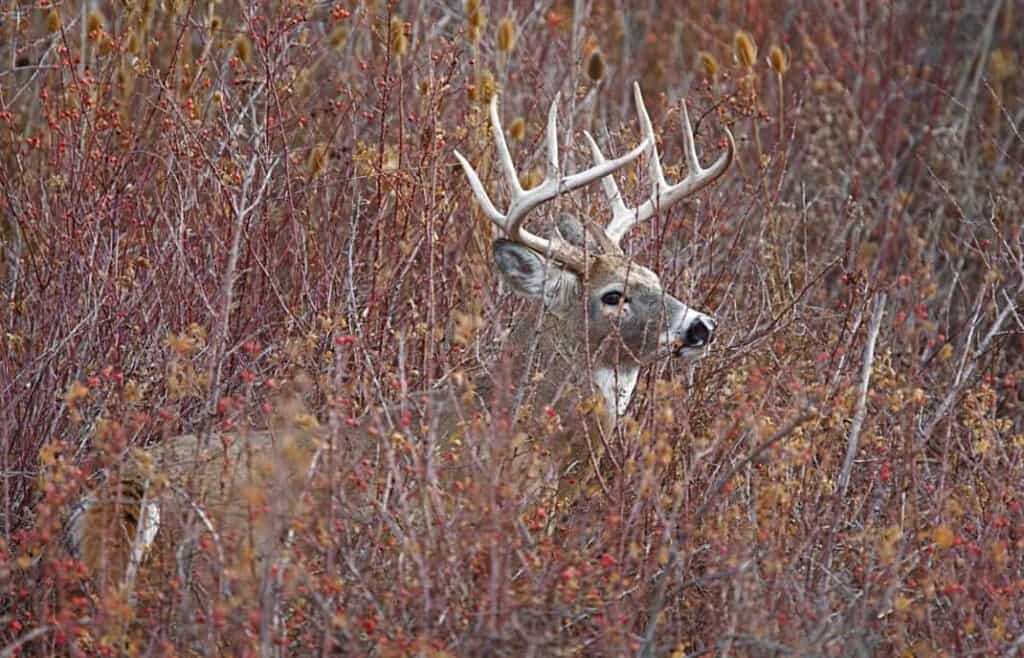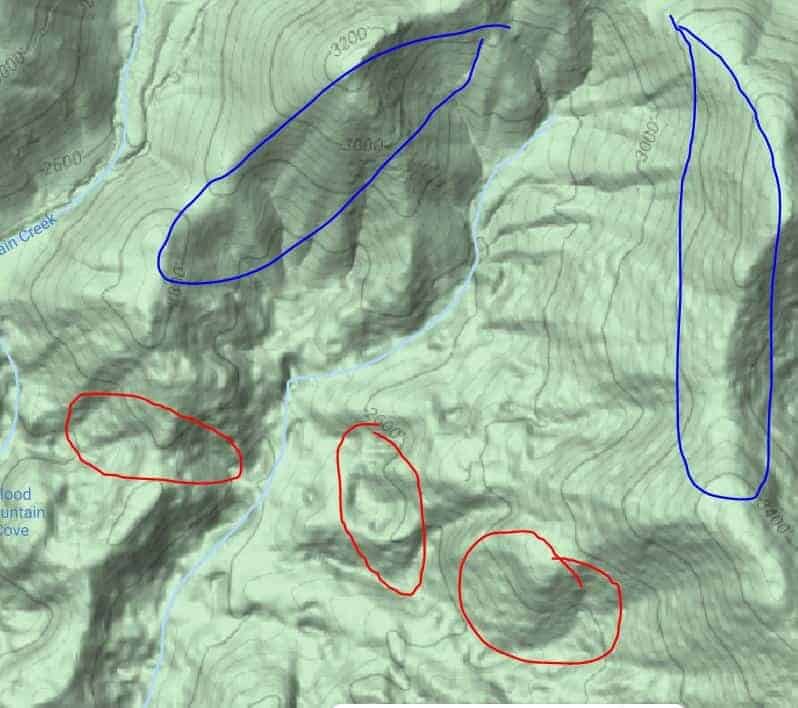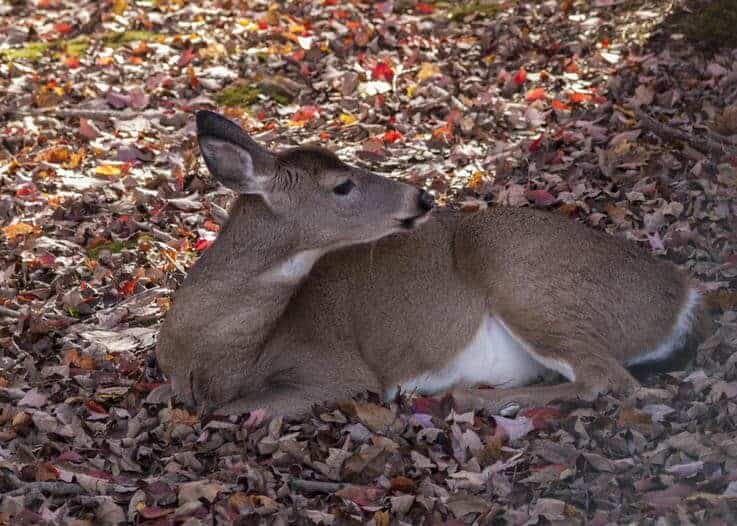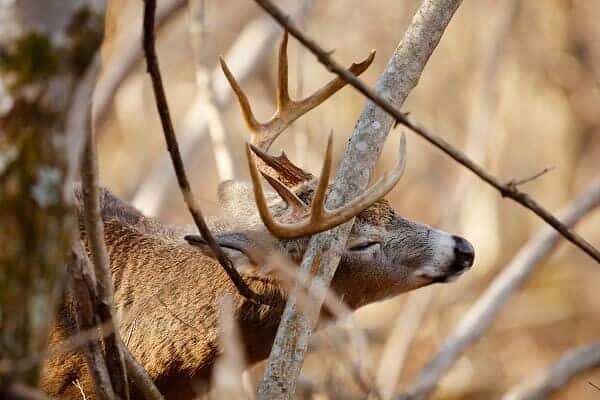Finding a buck bedding area can be a challenge, but finding a buck bed on public property can be even harder. There are a lot of hunters on public land, so there is a lot of deer pressure. Pressured bucks can be hard to hunt, and it can be difficult to find their bedding areas. If you can manage to get through the common areas of public land and hunt in an area that is not as hunter-dense, you can have a much higher success rate. Bucks are very strategic about where they bed, so to find a public land buck bedding area, you need to think like a public land buck. Knowing how to find buck beds and how to hunt them can be a rewarding skill and will help you become a better hunter.
Public Vs Private Bedding Areas
When on private land deer beds may not be as difficult to find. Using the methods I will discuss later, you could locate a general area where deer are bedding pretty quickly. If private landowners manage their land well, their deer will not be pressured. This allows deer to move around more often and to more open areas. In contrast, public land deer may stick to low quality food in thick hardwoods, rather than walking out to food plots or field edges. They will also stay away from easy to hunt areas, and bed farther into the public land because there are fewer hunters there.
Deer like to bed down in the thickest and most protected areas. Hunters normally hunt around food sources and the trails between beds; however, if you can locate an area where deer are bedding down, you will have an advantage over other hunters. There is a reason that many hunters do not hunt bedding areas on public land. It is because the pressured deer like to go far into the woods and bed in the hardest areas to get to. So it can be a lot of work to find these areas, and it is also difficult to hunt them.

How To Find Public Land Buck Bedding Areas
Being able to find and hunt bedding areas can give you a huge edge over other public land hunters. Many of them hunt easy to find or easy to scout areas that have regular doe traffic with the occasional buck. As you will soon find out, you can tell the difference between a doe and a buck bed during the rutting season. Knowing what to look for to find a buck bed is the first step. There are a few key indicators that can quickly tell us if a bed belongs to a buck or a doe.
Deer are smart, so they pick the most strategic areas to bed down. When we think like a buck, even with thousands of acres to cover, we can locate a general area of a buck bed fairly quickly with a topographical map and knowledge of the habitat.
RELATED POST: COMPLETE GUIDE TO AGING WHITETAIL DEER
Where Do You Find Buck Bedding Areas?
Using Maps
Before you put boots on the ground, it is a good idea to do your homework. Looking at maps can give you a better idea of the layout of the land in a short amount of time. This is much better than walking hundreds of acres. Learning to use maps is important and can cut down on scouting time, but it is not an exact science. Just because an area may look good from the maps’ point of view, does not mean there will always be buck beds there. Before you hang a stand, you will need to scout the areas you selected in person.
There are two types of maps you can use, satellite maps, and topographical maps. It is important that you look at both. Both of these maps have their benefits. The main map you want to use is the topographical map. When you look at a topo map, you see ridges and contours of the land. You can use the contour lines to estimate where bucks will bed.

You want to look for areas that will offer good protection. When bucks bed they need to be able to see a long way in front of them and smell what is behind them. They do this by bedding at points and on ridges. You can see in this picture that we expect to see buck beds at the red circles representing points, or in the blue circles representing ridges. Bucks generally will not bed at the very top of hills, but slightly lower in the slope.
Bedding like this gives the buck a height advantage which allows him to see very far in front of him. Staying below the ridgeline lets him smell threats on top of the hill before they could ever see him. Although if the wind comes from the east instead of the west, we would expect him to bed on the other side of the depression. So when looking at a topographical map you want to look for places that would give the buck these advantages. Chances are there are plenty of areas like this, but the land configuration is not the only factor.
Next, you need to think about which areas have the least amount of hunters. This is more than likely going to be the area that is the hardest to get to. Easy areas to get to will be hunted more and therefore be higher pressure areas for bucks. High hunting pressure will make bucks avoid the area. After this elimination, you need to think about the next factor, cover.
Other than being able to see ridgelines and slopes, you need to be aware of the available cover. Deer like to bed in thick brush for a reason, it provides cover and safety. Using a satellite map you can see which areas are more densely covered and which areas are thinner. Your goal is to locate a good strategic location on the topo map that is secluded from most hunters. Switch to the satellite map to make sure it has adequate cover for deer. After finding a few of those areas, spend a day scouting them. This is not an exact science, so it is important that you get out to those areas and look for the important characteristics of buck bedding areas that we will discuss later.

Habitat Type
Scouting buck beds from maps is an elimination game. Just knowing a little about the habitat can save you days of scouting on the ground. There are many different types of terrain that we hunt, some are easier to hunt than others. For example, if you have hundreds of acres of habitat that is difficult to hunt like a marsh, but have 20 acres of hardwoods on the side, you do not want to try to hunt the middle of the marsh. Even if it has good topo lines and coverage. Deer, in general, love to hang around the edges of these habitats, so consider how the habitat affects deer movement.
Characteristics Of Bedding Areas
Now that you have a general idea of where to start looking for bedding areas, what do they look like? There will be a number of impressions on the ground where the deer was laying. You can probably guess which direction the deer was laying based on the surroundings. They will lay away from the wind so they can see downwind and smell upwind. They will also bed with something to their backs, like a fallen tree, cliffside, or large rock. You can expect there to be plenty of deer sign around the area as well.
Buck Vs Doe Bedding Areas
How do you tell the difference between buck and doe beds? Well if you are scouting after bucks have broken up from their coalitions, the number of impressions on the ground should be the first give away. Doe groups will bed together, and normally in more exposed locations than bucks because they have numbers on their side. A single buck needs to put himself in the strategic situation that we have been talking about, but does will need just general cover and may or may not take advantage of topography. Unlike a buck, does have eyes looking everywhere and more than one nose. There is safety in numbers and this is a huge benefit that does have throughout the year.

RELATED POST: THE WHITETAIL RUT: WHAT WHAT & WHEN IS IT?
To know that you are looking at a buck bed you should see only one impression and buck sign. A cluster of tree rubs in the general area is a good indication that it is a buck bed. Also, look for a nearby scrape, they will not be as close as the rubs. When you do find a public land buck bedding area, do not spend too much time there and do not hunt on top of it. Hunt close to the funnels leading to it. An in-depth guide to hunting buck beds will be coming soon…
RELATED POST: WHY DO BUCKS RUB TREES?
Conclusion
When you are looking for public land buck bedding areas, you should first scout out a general area using topographical and satellite maps. Be aware of how other hunters are hunting on the public land so you know where the least deer pressure is. Use the maps to locate areas that hunters do not hunt frequently. These areas will probably be the hardest to get to. Also, use the maps to find secluded ridges and points that have plenty of coverage. Once you put boots on the ground, you are looking at the number of impressions on the ground and the right type of sign around the bedding area. For public land buck bedding areas, you really need to emphasize the importance of cover for deer. They are going to retreat to these thick areas due to hunting pressure, so you need to be ready to pursue them in it.
Thanks for reading my article about public land buck bedding areas. I hope you enjoyed it and learned something you didn’t already know. If you like my content, subscribe to my weekly update. If you have any other questions about public land buck bedding areas or just want to connect, feel free to email me at [email protected].

